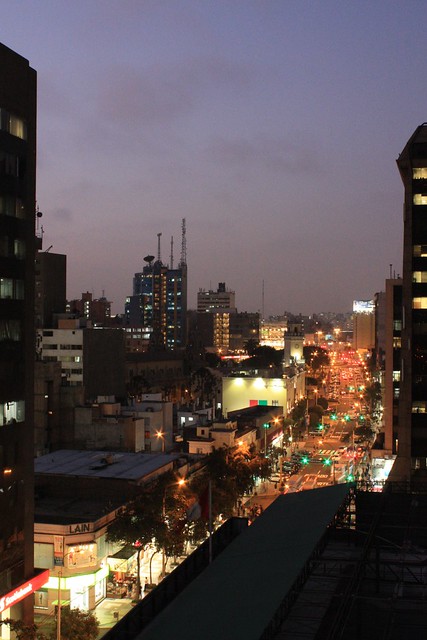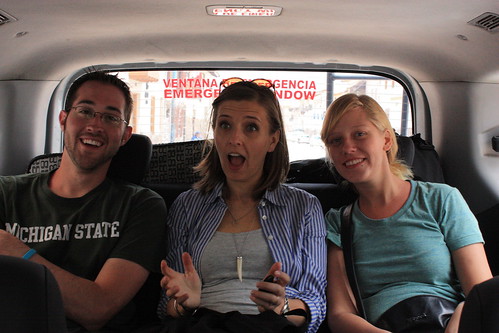The Definitive Guide to Taxi Cabs in Peru – Fares, Bargains, and Scams

The city of Lima: plenty of cabs, plenty of chances to haggle.
–
Haggling is an art form, and my mother is Picasso. Analyze her technique too closely, and it will fall apart, but stand back far enough, and a masterpiece emerges. I’ve seen her haggle in retail stores. RETAIL STORES. With success. She will take an item up to the cashier and note that a thread is coming loose – would they mind giving her a discount? Or she’ll point out a popped button, a fraying hem (all things which she can fix in a matter of moments) and ask for a ludicrous percentage off.
AND SHE WILL GET IT.
I thought about her a lot when I was in Peru. Not only is haggling a way of life down there, it’s institutionalized – nothing seems to have a fixed price. Not even the cabs. That’s right: you haggle for cab fares in Peru. None of the vehicles have meters. You simply talk to a driver and negotiate the price before getting in.
For me, this was incredibly nerve-wracking. I didn’t inherit my mother’s knack for seeking out a bargain. I tried once to get a deal on a sweater that was – I kid you not – coming apart at the seams. The cashier offered me 10% off. I stared at her blankly before putting it back on the rack. My mother would have been paid to take it off the store’s hands.
I’m just no good at fighting over money. I hesitate to even point out when I’m overcharged for fear of an embarassing exchange with a store clerk. And besides all of that, my Spanish is not perfect. Not even close. In Italian or English, I’d be fine. But how on earth was I supposed to tell a Peruvian cab driver that I knew he was charging me too much when I could barely speak the language?
Miraculously, I managed to do it. Here are the lessons I learned from my week of hailing and bargaining for cabs in Peru – both in Lima and Cuzco. Hopefully it will come in handy if, like me, you lack my mother’s amazing bargaining skills.
- Negotiate the fare beforehand. This is the most important thing to know before you hail a cab in Peru: you and the driver agree on a price before you get in. Once you are on your way, you can’t renegotiate – trying to short change your driver after you’ve established a fare is unacceptable. And getting in without setting a price is just a recipe for getting ripped off.
- Don’t be afraid to walk away. If a proposed fare too high, don’t hesitate to say “no” – you are not going to offend the driver (and if you do, really, WHEN are you going to see him again?) During our trip, everyone had piled into a minivan to head back to the hotel. Seeing this, the driver came at me with a ludicrous number. Fortunately, Casey had seen my face, and was willing to drag everyone out of the vehicle at a moment’s notice. Seeing that we were willing to say no, the driver came down on his price – by nearly 50%.
- Be wary of anyone who approaches you (especially in the airport). Odds are they are going to come at you with a number that is much higher than what you’d get if you just step outside on to the curb.
–
These cabs were lined up outside a museum, just behind a tour bus.
–
- Ask to see the vehicle. This will give you better negotiating power. Rand and I spoke to one driver who wouldn’t take us to the airport for less than 45 soles (about $20). It’s not a bad rate for tourists, but still much heftier than that of his colleagues. But when we saw his car – a pristine vehicle with A/C and leather seats, we figured it was worth the splurge.
- Watch out for drivers that work for your hotel. Many places will offer to pick you up from the airport as a complimentary service (check ahead if you want to do this – it helps alleviate a lot of stress, particularly when you’ve just landed). But be cautious if you want to travel from your hotel out into the city – the driver, knowing you are out-of-towners, may try to rip you off (ours did, claiming our destination was really far away. Even his colleague looked at him like he was full of shit.) Instead, ask the bell hop to hail you a cab off the street, or better yet, walk a block or two away from your hotel and do it yourself.
- Move away from tourist destinations before hailing a cab. If you are standing right outside the Larco Museum, odds are you’ll be given a much heftier price than if you stand outside a cafe where all the locals are congregating. Consider wandering a little bit down the block to grab a cab.
- Tipping isn’t customary. Since you’ve already set a price beforehand, that is all you are expected to pay. Rand couldn’t break the habit of adding a tip, which was sweet, but unnecessary (a few drivers gave him an appreciative slap on the back when he handed them an extra 5 soles – roughly $2)
- Guard your valuables. Peru felt surprisingly safe – even in the sketchier areas. Still, there’s no need to tempt fate. We’d heard a horror story or two about cab windows being smashed in and bags being snatched (it’s rare, but it does happen). The best way to avoid this is to make yourself a hard target. Wrap your bag strap around your arm, tuck your backpack between your legs, or out of site. And lock your doors.
- Ask a local. Since we had no frame of reference about how much cabs should have cost, we checked with the locals. They gave us broad tips which proved helpful (a ride from Lima to the airport – which took nearly 40 minutes – was about 40 soles – or $15 US. Any cab from one part of Cuzco to another shouldn’t cost more than 4 or 5 soles – $2 U.S.)
- Most drivers accept U.S. currency. In fact, most places in Peru accept U.S. dollars – so be sure to clarify what currency you are paying in, and don’t let a driver try to charge you more if you paying in dollars – they won’t have any trouble getting rid of their cash.
- Don’t be afraid to use your rudimentary Spanish. Cab drivers want to understand you – after all, you’re going to pay them. You’ll be surprised at how far you can get with just a few words. Grab a phrasebook and learn how to say things like, “How much?” and “How long will it take to get there?” Try to commit some numbers to memory, but don’t worry if you can’t – you can always write down some rates and haggle that way.
–
Since no one else on the trip spoke Spanish, they had to put up with me.
–
- Bring a map. Like I said, very few drivers will speak English. A map will help you communicate where you need to go, and give you an idea of how long the journey will be (and consequently, how much it should cost). It will also show that you aren’t totally clueless – something which comes in handy when trying to negotiate a fare.
I’m pleased to say we only got really ripped off once. The hotel driver told us that the destination was far away, and the trip would cost 20 soles ($7 U.S.). I told him that seemed unreasonable but he insisted that it was very, very far and unwalkable. I gave in, and he proceeded to drive us a few blocks away. I was infuriated, and tempted to scream at him (while I’ve forgotten most of the Spanish I’ve ever known, I’ve committed to memory choice words like “thief”, “liar”, and “son of a bitch”. I am slightly concerned as to what this says about my personality) but thought better of it when I realized IT WAS ONLY SEVEN FRIGGIN DOLLARS. That’s the thing to remember about Peru – even when you are ripped off, you’re still getting a pretty good deal.
And hey – it’s waaaay cheaper than the cabs in Bulgaria. But still – next time I go to Peru? I’m taking my mom.









Leave a Comment